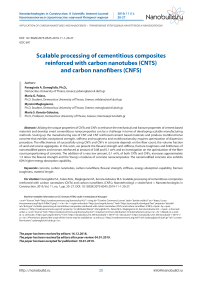Scalable processing of cementitious composites reinforced with carbon nanotubes (CNTS) and carbon nanofibers (CNFS)
Автор: Danoglidis P.A., Falara M.G., Maglogianni M., Konsta-Gdoutos M.S.
Журнал: Nanotechnologies in Construction: A Scientific Internet-Journal @nanobuild-en
Рубрика: Application of carbon nanotubes and nanofibers in concrete
Статья в выпуске: 1 Vol.11, 2019 года.
Бесплатный доступ
Utilizing the unique properties of CNTs and CNFs to enhance the mechanical and fracture properties of cement based materials and develop smart cementitious nanocomposites can be a challenge in terms of developing scalable manufacturing methods. Scaling up the manufacturing size of CNT and CNF reinforced cement based materials and produce multifunctional concrete that exhibits exceptional strength, stiffness and toughness and multifunctionality requires optimization of dispersion procedure. The effectiveness of successfully using CNTs and CNFs in concrete depends on the fiber count, the volume fraction of sand and coarse aggregates. In this work, we present the flexural strength and stiffness, fracture toughness and brittleness of nanomodified pastes and mortars reinforced at amount of 0.08 and 0.1 wt% and an investigation on the optimization of the fiber count proportioning of concrete. The addition of a very low amount, 0.1 wt%, of both CNTs and CNFs, increases approximately 1.5 times the flexural strength and the Young`s modulus of concrete nanocomposites. The nanomodified concrete also exhibits 60% higher energy absorption capability.
Concrete, carbon nanotubes, carbon nanofibers, flexural strength, stiffness, energy absorption capability, fracture toughness, material length
Короткий адрес: https://sciup.org/142227518
IDR: 142227518 | DOI: 10.15828/2075-8545-2019-11-1-20-27
Список литературы Scalable processing of cementitious composites reinforced with carbon nanotubes (CNTS) and carbon nanofibers (CNFS)
- Shah S.P.,Ouyang C. Mechanical behavior of fiberreinforced cement-based composites. Journal of the American Ceramic Society.1991, Vol. 74, no. 11, pp. 2727–2953. Available at: https://onlinelibrary.wiley.com/doi/abs/10.1111/j.1151-2916.1991. tb06836.x.
- Xu S., Li Q. Theoretical analysis on bending behavior of functionally grated composite beam crack controlled by ultrahigh toughness cementitious composites. Science in China Series E: Technological Science. 2009, Vol. 5, pp. 363–378. Available at: https://link.springer.com/article/10.1007/s11431-008-0337-9.
- Danoglidis P.A., Konsta-Gdoutos M.S., Gdoutos E., Shah S.P. Strength, energy absorption capability and self-sensing properties of multifunctional carbon nanotube reinforced mortars. Construction and Building Materials. 2016, Vol. 120, pp. 265–274. Available at: https://www.sciencedirect.com/science/article/abs/pii/S0950061816307747.
- Gdoutos E.E., Konsta-Gdoutos M.S., Danoglidis, P.A. Portland cement mortar nanocomposites at low carbon nanotube and carbon nanofiber content: Α fracture mechanics experimental study. Cement and Concrete Composites. 2016, Vol. 70, pp. 110–118. Available at: https://www.sciencedirect.com/science/article/pii/S0958946516300543.
- Abu Al-Rub R.K., Tyson M., Yasdanbakhsh, A., Grasley Z. Mechanical Properties of Nanocomposite Cement Incorporating Surface-Treated and Untreated Carbon Nanotubes and Carbon Nanofibers. Journal of Nanomechanics and Micromechanics. 2012, Vol. 2, no. 1, pp. 1–6. Available at: https://ascelibrary.org/doi/10.1061/%28ASCE%29NM.2153-5477.0000041.
- Manzur T., Yazdani, N. Optimum mix ratio for Carbon Nanotubes in cement mortar. KSCE Journal of Civil Engineering. 2015, Vol. 19, no. 5, pp. 1405–1412. Available at: https://link.springer.com/article/10.1007/s12205-014-0721-x.
- Shah SP, Konsta-Gdoutos MS, Metaxa ZS. Highly dispersed carbon nanotube reinforced cement based materials. United States Patent US9,365,456 (B2) – 2016-06-14.
- Hersam MC, Seo J-WT, Shah SP, Konsta-Gdoutos MS, Metaxa ZS. Highly concentrated nano-reinforcement suspensions for cementitious materials and method of reinforcing such materials. United States Patent, US8,865,107(B2)-2014-10-14.
- Shah SP, Konsta-Gdoutos MS, Metaxa ZS. Highly dispersed carbon nanotube reinforced cement based materials. United States Patent No. 9,499,439 (B2) – 2016-11-22.
- American Concrete Institute, 1996. Repost on Fiber Reinforced Concrete, ACI 544.1R-96.
- Chen YL, Liu B, He XQ, Huang Y, Hwang KC. Failure analysis and the optimal toughness design of carbon nanotubereinforced composites. Composites Science Technology. 2010, Vol. 70, no. 9, pp. 1360-1367. Available at: https://www.sciencedirect. com/science/article/pii/S0266353810001600.
- Chen YL, Wang S, Liu B, Zhang J. Effects of geometrical and mechanical properties of fiber and matrix on composite fracture toughness. Composite Structures. 2015, Vol. 122, pp. 496-506. Available at: https://www.sciencedirect.com/science/article/ pii/S0263822314006679.
- Zhu X, Gao Y, Dai Z, Corr J, Shah SP. Effect of interfacial transition zone on the Young’s modulus of carbon nanofiber reinforced cement concrete. Cement and Concrete Research. 2018, Vol. 107, pp. 49–63. Available at: https://www.sciencedirect. com/science/article/pii/S0008884617308839.


